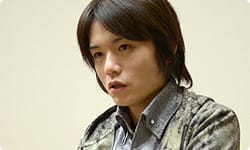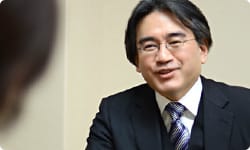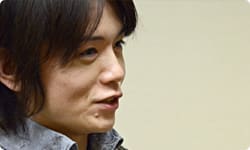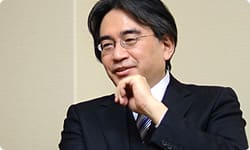Examples of Disassembly and Reassembly
We talked about that during the session of "Iwata Asks" over Super Smash Bros. Brawl.
When you hear fighting games, you can't help but to think of having to execute fancy combos.
Fighting games had developed in a way that the person who can pull off combos the best gets stronger and stronger.
But I do like the organic, ad lib nature that happens distinctively in fighting games, rather than learning specific ways to get stronger.
As a player, however, aren't you really good at unleashing combos? You seem to have been very good at it.
Oh no, I can only do easy ones. If I looked good to you, that was because I was winning at reading my opponent.
Oh, I see.
Recently, I played a new fighting game that had a combo practice mode, but no matter how much I practiced, I could only do about 5 of the 16 available. Really, I was like, "I can't play today's fighters!" I'm also not as young as I use to be.
(laughs)
But I had sensed that for a long time, so instead of asking players to pull off specific combos that require instant elaborate manipulation, I wondered how I could bring out an element of ad lib.
To you, the element of ad lib was the fun core of fighting games.
Right. Every time you fight, your opponent's reactions change. Instead of set combos, how to react to changing situation is more important. That became the basis of the idea of cumulative damage.
Oh, so that was a reason behind the idea of being able to blow away your opponent when their cumulative damage had built up?
Come to think about it, didn't we talk about this before? As a matter of fact, it’s a really simple thing. Fighting games seems to be like it’s about making specific combos, but I wondered how we could draw out that element of ad lib that I liked so much and thought it would be fun to have the reactions change every time. The result was putting in cumulative damage.
By doing that, what you need to do will change depending on the situation. Players will engage in more ad lib—including the by-chance happenings that occur when players who aren't very good are just punching buttons that can change the course of play. Is that right?
Right.
Now so many people have played it, so if you told them that Super Smash Bros. is that kind of game, they would understand.
Yes.
But hearing this before playing it, not many people would say, "Oh, that sounds fun!"
Hmm, I suppose not. (laughs)
When you made Kirby Air Ride, what kind of disassembly and assembly took place?
First I thought about our general notions of the acceleration and drifting.
Because it's a racing game.
Right. And like why drifting feels good.
What conclusion did you reach?
We decided that drifting feels so good because there's risk involved. Under normal grip conditions, the tires don't slide and the vehicle is stable, so you drive with little risk. Now if you drift while you may lose control and there's a greater danger of going off-course and get it done, that feels awesome.
It feels better when you run risk. There's a return of being able to drive faster.
Right. Before anything, drifting lies at the root of the concept of Kirby Air Ride.
The design of the controls for Kirby Air Ride was unique in the way there was no accelerator button.
The A Button isn't the accelerator, but the brakes. It's unique, so it was also hard to understand. (laughs)
Racing games had always been composed of an accelerator, brakes and the steering wheel, but you changed that.
But it wasn't like we set out to overturn the accelerator-brakes structure. This way of thinking might be like (Shigeru) Miyamoto-san's. He plays a game and designates the buttons based on what feels right.
Yes. When Miyamoto-san decides the controls, he places a lot of importance on whether the controls are matching his feelings when he plays it.
In Kirby Air Ride, the brakes aren't simply brakes. While the machines usually float, they shorten and sort of rub against the floor. We call that action "Push." When you hold down the button, you slow down, but you charge up power at the same time, so when you release the button, you release power and burst forward.
And if you pushed on a curve, you could drift, which felt great.
Yeah. The controls are the exact opposite of a conventional racing game. We did that because it suited the feeling of plunging ahead. But that may not have gotten across to the players from the beginning.
Is that because of the people who had experienced it and others who hadn't thought of the game differently?
Those who are into it really like it a lot. But even some people who had experienced it might have thought, "It's hard because it's the opposite of what I'm used to," when they first played it.
Because the controls were clearly a polar opposite than the other games they played.
On the other hand, a lot of people demanded a sequel, so many fans did thoroughly enjoyed it.
Once they get over that first hurdle that is part of your style, they can become immersed in how fun it is.
Looking around the genre, it may seem out of the ordinary, but we intended it all, and some of the fun comes from that.
How about when you made Meteos?
That was about risk and return also. We made it by asking ourselves, "What is the risk in a puzzle game?" Usually, puzzle games have blocks that fall from above, and it feels great when all at once you clear out a bunch that have piled up high.
Uh-huh.
The game's about to end when the blocks are stacked up high and there are a lot of risk, but it feels amazing if you can get rid of them all at once. What I paid attention to was the way you get rid of the stacks of blocks. I started by doubting whether getting rid of the blocks was something you really have to do.
In puzzle games up until then, it was common to slide in a long bar or line up colors to get rid of the blocks. You wondered if there was another way.
Right. So instead of getting rid of the blocks that have stacked up, you launch them up.
Why did you decide on that?
What I thought of at the time was reactive force.
Like a force that pushes back?
Yes. In other words, I thought a puzzle game could use the concept of resisting by pushing in the opposite direction as your opponent. At first, we did think of using a bomb to get rid of them, but to get rid of more, you raise them up together. In a word, I thought launching them up would be better and made Meteos that way.




